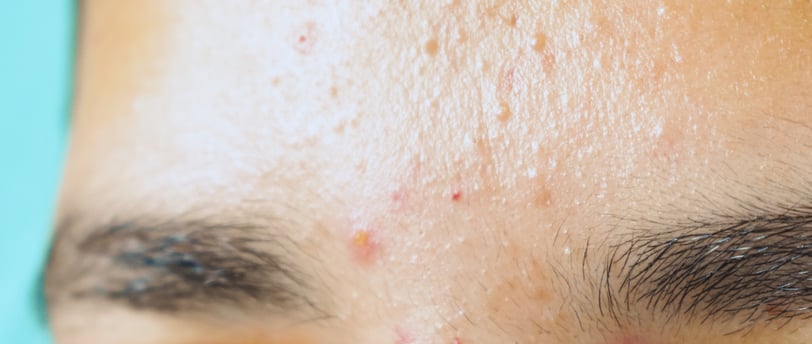How to Get Rid of Fungal Acne: Understanding, Identifying, and Treating It Naturally
In this blog, learn everything about fungal acne—from understanding what it is and how it looks to practical solutions and easy homemade remedies. We’ll guide you step-by-step on how to identify fungal acne, address its root causes, and restore your skin’s natural balance with simple yet effective tips. Say goodbye to stubborn bumps and hello to clear, healthy skin!
12/26/20243 min read


Fungal acne—it’s a term that often leaves people scratching their heads, quite literally. Many of us assume that acne is caused by clogged pores, oil, or bacteria, but fungal acne is different. It’s not actually "acne" at all. Fungal acne, also known as Malassezia folliculitis, is caused by an overgrowth of yeast on your skin. This yeast, which naturally lives on your skin, can become problematic when it grows out of balance, leading to itchy, inflamed bumps that can resemble traditional acne.
If you’ve been treating stubborn bumps with regular acne products but they refuse to go away, there’s a chance you’re dealing with fungal acne instead. Understanding what it is, how it looks, and how to treat it is the first step toward clear, healthy skin. In this blog, we’ll dive deep into fungal acne—what it is, how to identify it, and how you can effectively get rid of it with easy, practical solutions.
What Is Fungal Acne and What Causes It?
Fungal acne is a skin condition caused by an overgrowth of the yeast Malassezia, which lives on the surface of our skin. Normally, this yeast is harmless, but certain factors can trigger its overgrowth:
Hot and Humid Weather:
Yeast thrives in warm, moist environments, making fungal acne more common in tropical climates or during summer.
Sweat and Tight Clothing:
Wearing tight, non-breathable fabrics traps sweat and creates the perfect environment for yeast to grow.
Excess Oil Production:
An oily scalp, face, or body can feed the yeast, leading to an imbalance.
Certain Skincare Products:
Products with oils or fatty acids can exacerbate fungal acne by "feeding" the yeast.
Weakened Immune System or Antibiotics:
A weakened immune system or recent use of antibiotics can disrupt your skin's natural balance, encouraging yeast overgrowth.
How Does Fungal Acne Look?
Fungal acne can be tricky to identify because it looks similar to regular acne. However, there are some telltale signs:
Small, Uniform Bumps:
Unlike bacterial acne, which varies in size and type, fungal acne often appears as small, uniform bumps clustered together.
Itchy Skin:
Fungal acne is usually itchy, while traditional acne is not.
Location:
Fungal acne often appears on areas prone to sweat and oil, such as the forehead, chest, back, and upper arms.
No Whiteheads or Blackheads:
Fungal acne doesn’t form blackheads or large pustules like bacterial acne.
How to Get Rid of Fungal Acne
Getting rid of fungal acne requires targeting the yeast that’s causing the problem. Here’s how you can effectively treat it:
1. Use Antifungal Treatments
Over-the-Counter Options:
Products containing ketoconazole, clotrimazole, or miconazole can help kill the yeast.
Examples: Ketoconazole shampoo (used as a body wash) or antifungal creams from the pharmacy.
How to Use:
Apply the antifungal treatment to the affected areas daily. Leave shampoos on your skin for 5-10 minutes before rinsing.
2. Avoid Oil-Based Products
Avoid skincare products with oils, fatty acids, or heavy emollients, as these can feed the yeast. Opt for lightweight, water-based formulas.
3. Shower Immediately After Sweating
Yeast thrives on sweat. Showering immediately after exercising or sweating can help prevent fungal acne from worsening.
4. Exfoliate Gently
Use a gentle exfoliant with salicylic acid or sulfur to remove dead skin cells and unclog hair follicles without irritating your skin.
5. Wear Breathable Fabrics
Choose loose, breathable fabrics like cotton to reduce sweating and friction on your skin.
Homemade Solutions for Fungal Acne
Apple Cider Vinegar Toner
Mix equal parts apple cider vinegar and water. Apply to the affected areas with a cotton pad and leave it on for 10-15 minutes before rinsing.
Why It Works: Apple cider vinegar has antifungal properties that help balance your skin's pH.
Tea Tree Oil Spot Treatment
Mix 2-3 drops of tea tree oil with a teaspoon of carrier oil (like jojoba or almond oil). Apply it to fungal acne spots.
Why It Works: Tea tree oil has natural antifungal and antibacterial properties.
Aloe Vera and Turmeric Paste
Mix pure aloe vera gel with a pinch of turmeric and apply it to the affected area. Leave it on for 15-20 minutes before rinsing.
Why It Works: Aloe vera soothes inflammation, while turmeric fights fungal growth.
Yogurt Mask
Apply plain, unsweetened yogurt directly to your skin. Leave it on for 15-20 minutes before rinsing.
Why It Works: Yogurt contains probiotics that restore your skin’s natural balance and inhibit yeast overgrowth.
How to Care for Fungal Acne-Prone Skin
Keep Your Skin Dry:
Pat your skin dry after sweating or washing, especially in areas prone to fungal acne.
Maintain a Simple Routine:
Avoid layering too many products. A simple cleanser, antifungal treatment, and moisturizer are sufficient.
Eat a Balanced Diet:
Avoid excessive sugar and refined carbs, as they can feed the yeast. Focus on a diet rich in fruits, vegetables, and probiotics.
Wash Bedding and Towels Frequently:
Yeast can linger on fabrics. Wash pillowcases, bedsheets, and towels regularly to avoid re-infection.
Avoid Scratching:
Itching fungal acne can spread the yeast and worsen the condition. Soothe itchiness with cool compresses or aloe vera.
Explore
Discover tips for skincare, bodycare, and haircare.
Contact-
© 2024. All rights reserved.
